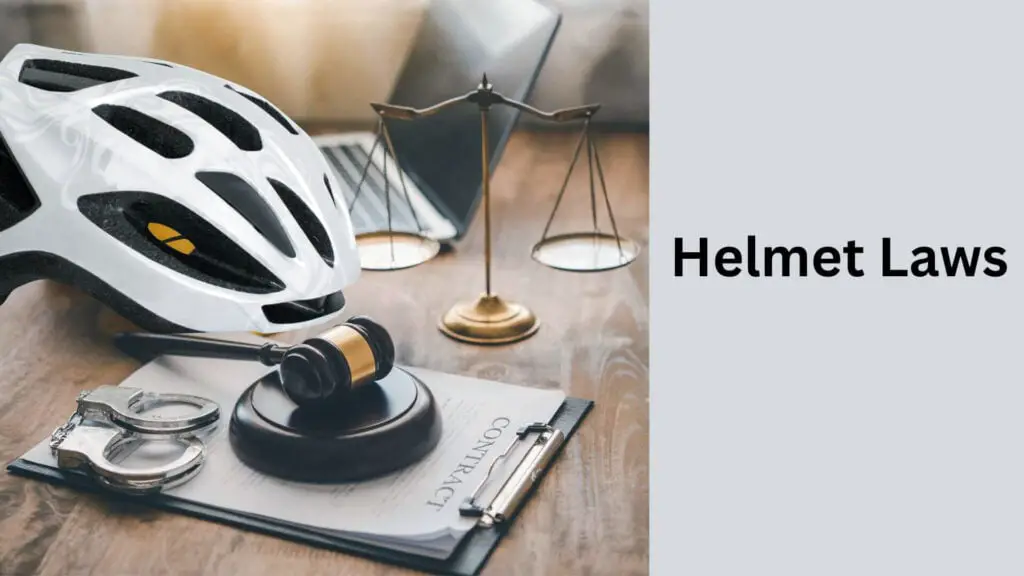Is it Illegal to Ride a Bike Without a Helmet?

Biking is a popular form of exercise and transportation, but many people wonder if it’s legal to ride without a helmet. This article will explore helmet laws worldwide, the arguments for and against wearing a helmet, and the consequences of riding a bike without one.
What is the Definition of Riding a Bike Without a Helmet?
Riding a bike without a helmet refers to operating a bicycle without wearing protective headgear. This means the rider is not wearing head protection, such as a helmet while cycling.
Importance of wearing a helmet while riding a bike

Wearing a helmet while riding a bike is important because it can reduce the risk of head injury in an accident. Helmets are designed to absorb shock and protect the head from serious injuries, such as skull fractures, traumatic brain injuries, and even death. Studies have shown that helmets can reduce the risk of head injury by up to 85%.
In addition to protecting in an accident, helmets also improve visibility and make riders more visible to motorists and other cyclists. This is important in reducing the risk of accidents and ensuring the safety of all road users.
Overall, wearing a helmet while riding a bike is a simple and effective way to reduce the risk of severe injury and is highly recommended by safety organizations and health professionals.
Read More: Things to Look for in the Best Road Bike Helmet Under $100
Helmet Laws Around the World
Helmet laws vary from country to country. In the United States, helmet laws are determined at the state level; not all states have mandatory helmet laws.
Currently, 21 states and the District of Columbia have laws requiring helmets for children under a certain age. In comparison, only three states (California, New Jersey, and Maryland) require all riders to wear helmets.
In the United Kingdom, it is not a legal requirement for adult cyclists to wear helmets, although the government recommends it.
Read More: Do Bike Helmets Expire?
What differences in helmet laws from country to country?
In some countries, such as Australia and New Zealand, helmets are mandatory for all cyclists, regardless of age. In other countries, such as the United Kingdom, helmets are not legally required for adult cyclists.
In the United States, helmet laws are determined at the state level; not all states have mandatory helmet laws. Currently, 21 states and the District of Columbia have laws requiring helmets for children under a certain age.
In comparison, only three states (California, New Jersey, and Maryland) require all riders to wear helmets.
In some countries, such as the Netherlands and Denmark, there is a cultural norm of not wearing helmets, and few people wear them while cycling. However, these countries have well-developed cycling infrastructure and a lower rate of cycling accidents compared to countries where helmets are mandatory.
It is essential to be aware of the helmet laws in your area and always follow them while cycling. Failure to do so can result in fines or legal consequences. To find out the helmet laws in your area, you can research online or consult with a local biking organization.
Read More: Are Bicycle Helmets Dot Approved in Your State?
An Overview of helmet laws in the USA & UK

Helmet laws in the United States and the United Kingdom are determined at the state/provincial, and national levels, respectively.
In the United States, helmet laws are determined at the state level; not all states have mandatory helmet laws. Currently, 21 states and the District of Columbia have laws requiring helmets for children under a certain age. In comparison, only three states (California, New Jersey, and Maryland) have laws requiring all riders to wear helmets.
In the United Kingdom, it is not a legal requirement for adult cyclists to wear helmets, although the government recommends it. There is no law requiring children to wear helmets, but it is widely advised for children under the age of 14.
It is essential to be aware of the helmet laws in your area and always follow them while cycling. Failure to do so can result in fines or legal consequences. To find out the helmet laws in your area, you can research online or consult with a local biking organization.
Read More: How to Clean Bike Helmet?
The Pros and Cons of Using a Helmet
The argument for wearing a helmet is that it can reduce the risk of head injury in the event of an accident. Helmets are designed to absorb shock and protect the head from serious injury.
On the other hand, opponents of mandatory helmet laws argue that they discourage people from cycling, as they are seen as uncomfortable and inconvenient.
Some studies have also suggested that the increased safety provided by helmets may encourage people to take more risks while cycling.
Advantages of wearing a helmet
- Reduced risk of head injury: Helmets are designed to absorb shock and protect the head from serious injuries, such as skull fractures and traumatic brain injuries. Studies have shown that helmets can reduce the risk of head injury by up to 85%.
- Improved visibility: Helmets improve visibility and make riders more visible to motorists and cyclists. This is important in reducing the risk of accidents and ensuring the safety of all road users.
- Increased comfort: Many modern helmets are designed to be lightweight and well-ventilated, making them comfortable to wear, even on hot summer days.
- Legal compliance: In many countries, wearing a helmet while riding a bike is a legal requirement. Failure to wear a helmet can result in fines or legal consequences.
- Personal responsibility: Wearing a helmet is a personal responsibility that riders can take to ensure their safety while cycling.
- Enhanced performance: Some cyclists wear helmets to help improve their performance by reducing wind resistance and keeping the head cool during intense rides.
- Peace of mind: Wearing a helmet provides peace of mind for riders and their loved ones, knowing that they are taking steps to protect their heads in the event of an accident.
Read More: Can You Use a Bike Helmet for Skiing?
Disadvantages of wearing a helmet
- Reduced comfort: Some cyclists may find helmets to be hot, heavy, or uncomfortable to wear, especially on long rides.
- Reduced visibility: Some cyclists may feel that helmets obstruct their vision or make them more difficult for motorists to see.
- Cost: Helmets, especially high-end models, can be expensive and may not be affordable for some riders.
- Reduced freedom: Some cyclists may feel that wearing a helmet restricts their freedom and enjoy riding without one.
- Cultural stigma: In some countries, a cultural stigma is associated with wearing helmets, and some cyclists may feel that they look uncool or uncool while wearing one.
- Misperceptions: Some cyclists may believe that helmets are not necessary or do not provide adequate protection in the event of an accident.
- Unattractive appearance: Some cyclists may feel that helmets are unattractive or ruin their appearance while riding.
Debate on the effectiveness of helmets
The effectiveness of helmets as a means of protecting cyclists has been the subject of much debate and scientific research.
On the one hand, studies have shown that helmets can significantly reduce the risk of head injuries and fatalities in the event of an accident. The helmet’s design helps absorb shock and protect the head from severe injuries like skull fractures and traumatic brain injuries.
However, some arguments suggest that helmets are ineffective in preventing injury or may even increase the risk of injury in some circumstances.
For example, some studies have suggested that helmets may give cyclists a false sense of security, leading them to take more significant risks while riding.
Some argue that helmets may not provide enough protection for certain types of accidents, such as high-speed collisions or motor vehicle accidents.
The debate on the effectiveness of helmets continues, and there is still much to be learned about how helmets can best be used to protect cyclists.
In the meantime, it is essential for cyclists to be aware of the available evidence and to make informed decisions about whether or not to wear a helmet while riding.
Ultimately, choosing a helmet is personal, and riders should consider the risks and benefits of helmet use in light of their cycling habits and preferences.
Consequences of Bicycle Riding Without a Helmet

If you choose to ride a bike without a helmet, you risk severe injury or death in the event of an accident. In addition to the health risks, you may also face legal consequences and fines, especially if you are in a state or country with mandatory helmet laws. Your insurance company may also choose not to cover your medical expenses if you are found to be riding without a helmet.
1. Health risks and consequences:
Not wearing a helmet while riding a bike can result in serious health risks and consequences in the event of an accident. Without a helmet, cyclists are at greater risk of head injuries, such as skull fractures and traumatic brain injuries, which can be life-threatening and cause long-term disability.
2. Legal consequences and fines:
In many countries, wearing a helmet while riding a bike is a legal requirement. Failure to wear a helmet can result in legal consequences, such as fines or court appearances. The penalties for not wearing a helmet vary by country and state but can range from small fines to more significant penalties for repeated offenses.
3. Insurance consequences:
Not wearing a helmet while riding a bike can also have insurance consequences in the event of an accident. In some cases, insurance companies may refuse to pay a claim if the rider was not wearing a helmet at the time of the accident, even if it was not their fault. This can result in significant financial consequences for the rider and their family.
It is essential to be aware of the health risks, legal consequences, and insurance implications of not wearing a helmet while riding a bike and always to follow local helmet laws to ensure your safety and well-being.
FAQs Questions About Is it illegal to ride a bike without a helmet?
Is it illegal to ride a bike without a helmet?
The legality of riding a bike without a helmet varies by country and state. In many places, helmet use is required by law, while in others, it is only recommended but not mandatory. It is important to check local laws and regulations to determine whether or not wearing a helmet is required in your area.
Why is it important to wear a helmet while riding a bike?
Wearing a helmet while riding a bike is essential for safety reasons. Helmets help to absorb shock and protect the head from serious injury in the event of an accident. Studies have shown that helmets can significantly reduce the risk of head injuries and fatalities in cycling accidents.
What are the consequences of not wearing a helmet while riding a bike?
Not wearing a helmet while riding a bike can result in serious health risks, such as head injuries, as well as legal consequences, such as fines, and insurance implications, such as denied insurance claims. It is essential always to follow local helmet laws to ensure your safety and well-being while cycling.
Is wearing a helmet mandatory in all countries?
No, helmet use is not mandatory in all countries. The helmet laws vary by country and state, and it is important to check local laws and regulations to determine whether or not wearing a helmet is required in your area.
Summary of key points:
- Wearing a helmet while riding a bike is a crucial safety measure that can reduce the risk of head injuries and fatalities in the event of an accident.
- Helmet laws vary by country and state, but many places require cyclists to wear helmets while riding.
- The effectiveness of helmets in protecting cyclists is still the subject of much debate and scientific research.
- Not wearing a helmet can result in serious health risks, legal consequences, and insurance implications.

Hey, I’m Hrithik Hossain. I am the head of helmethacks.com, which specializes in safety helmets. I am looking to connect with anyone interested in purchasing a helmet or who has any questions about different types of helmets. I have over 8 years of experience as a helmet expert, and I can’t wait to help you find the perfect helmet for you. I can help you with any questions regarding helmets, from the best brands to fitting, style, and more! I really enjoy keeping people safe by ensuring they have the best protection possible.








It’s important to emphasize the significance of helmet laws in promoting safety for cyclists. In the United States, 22 states and the District of Columbia have taken a step in the right direction by enacting laws mandating helmets for children under a certain age. However, it’s worth noting that regulations for adult cyclists vary from state to state. Encouraging consistency in helmet laws across all states would further enhance cyclist safety and reduce the risk of serious injuries in accidents. As we continue to prioritize road safety, advocating for helmet usage among all age groups can significantly contribute to a safer cycling environment nationwide.